1lumen selects and reviews products personally. We may earn affiliate commissions through our links, which help support our testing.
Maratac Titanium Peanut-Beast review
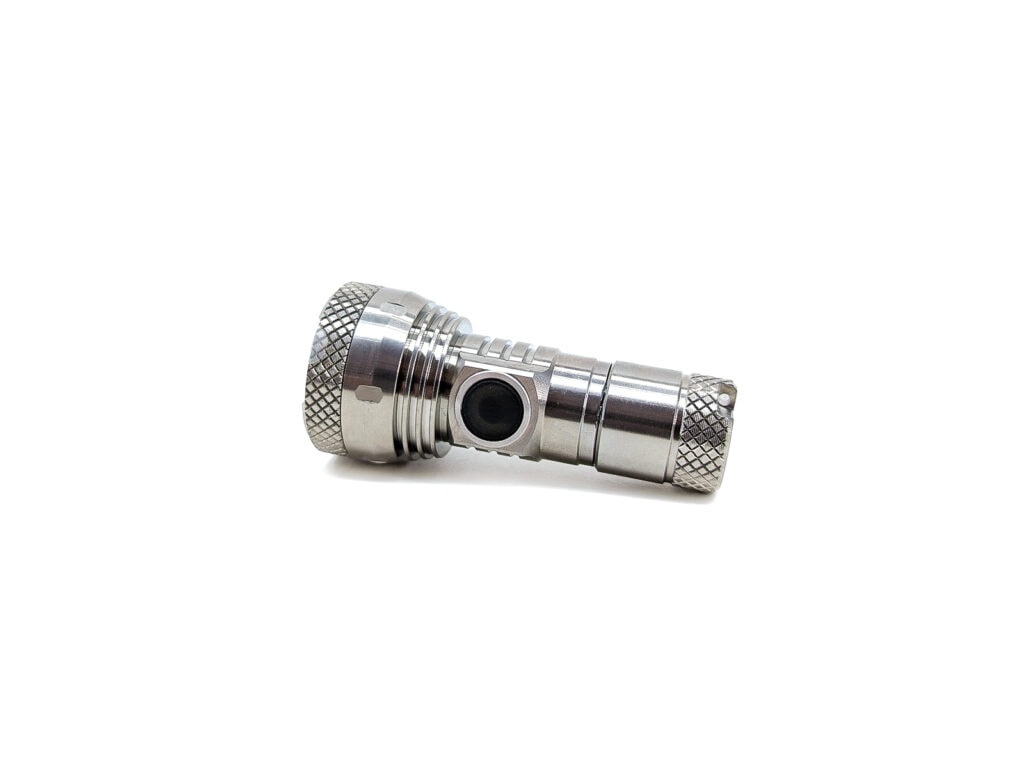
Maratac Titanium Peanut-Beast specs
| Brand & Model | Maratac Titanium Peanut-Beast |
|---|---|
| Flashlight category | Keychain / long-range |
| LED | Osram KW CSLNM1 |
| Max. output | 520 lumens |
| Max. beam distance | 311 meters |
| Max. beam intensity | ?cd |
| Battery config. | 1x 10180 |
| Onboard charging | No (but includes a mini charger) |
| Modes | 5 |
| Blinkies | N/A |
| Waterproof | IP68 |
| Review publication date | April 2023 |
Review intro:
The Maratac brand of flashlights are produced by/for a company called CountyComm. It’s a pretty neat company with a lot of awesome, high-quality products. In their own words: CountyComm designs, manufactures and sells select products to federal, state and local government agencies. Specializing in EDC ( Every Day Carry ) or in other places, Limited GOV overrun tactical goods brought to the consumer market. So… they make products to meet the exacting demands of US government agencies and then sell extras (or additional batches) directly to consumers. While I’ve purchased items from CountyComm before (like their excellent glow tape), I’ve never had one of their Maratac flashlights.
If you take a look at the Lights section of CountyComm’s website, you might begin to notice that these aren’t 100% original designs. Rather, it seems like CountyComm partners with other known brands (Lumintop, Reylight, Acebeam). The Maratac light may share a similar layout as an existing light, but will have unique aspects like a different UI, materials, or knurling.
CountyComm was kind enough to send their Maratac Titanium Peanut-Beast flashlight for testing. As you may have noticed in the summary table at the top, I’ve listed this as both keychain light and a long-range light. What an odd combination, huh? It may not be a crazy thrower, but for its size? This thing is intense! Which makes sense, because you might say this light has its origins as a nano version of the BLF GT (aka, “giga thrower” or “giggles thrower”).
To get started with the Titanium Peanut-Beast, you’ll need to remove the little isolation disc that separates the pre-installed battery from the driver. That’s there to prevent accidental activation before you receive it. Just throw that disc away, or do what I do – stick it back in the package in case you ever want to box the light up for safe keeping. Oh, and there’s a protective film over the lens – remove that, too.
Package quality.
The Maratac arrived in one of the most unusual packages I’ve seen: a 2-part clear plastic square tube. It is minimal yet sufficient packaging with everything securely tucked inside. All told, there was:
- Maratac Titanium Peanut-Beast
- Battery (10180, pre-installed)
- Charging head
- Charging cable
- Spare o-rings
- Lanyard
- Keychain clasp
- Small split ring
- Information cards
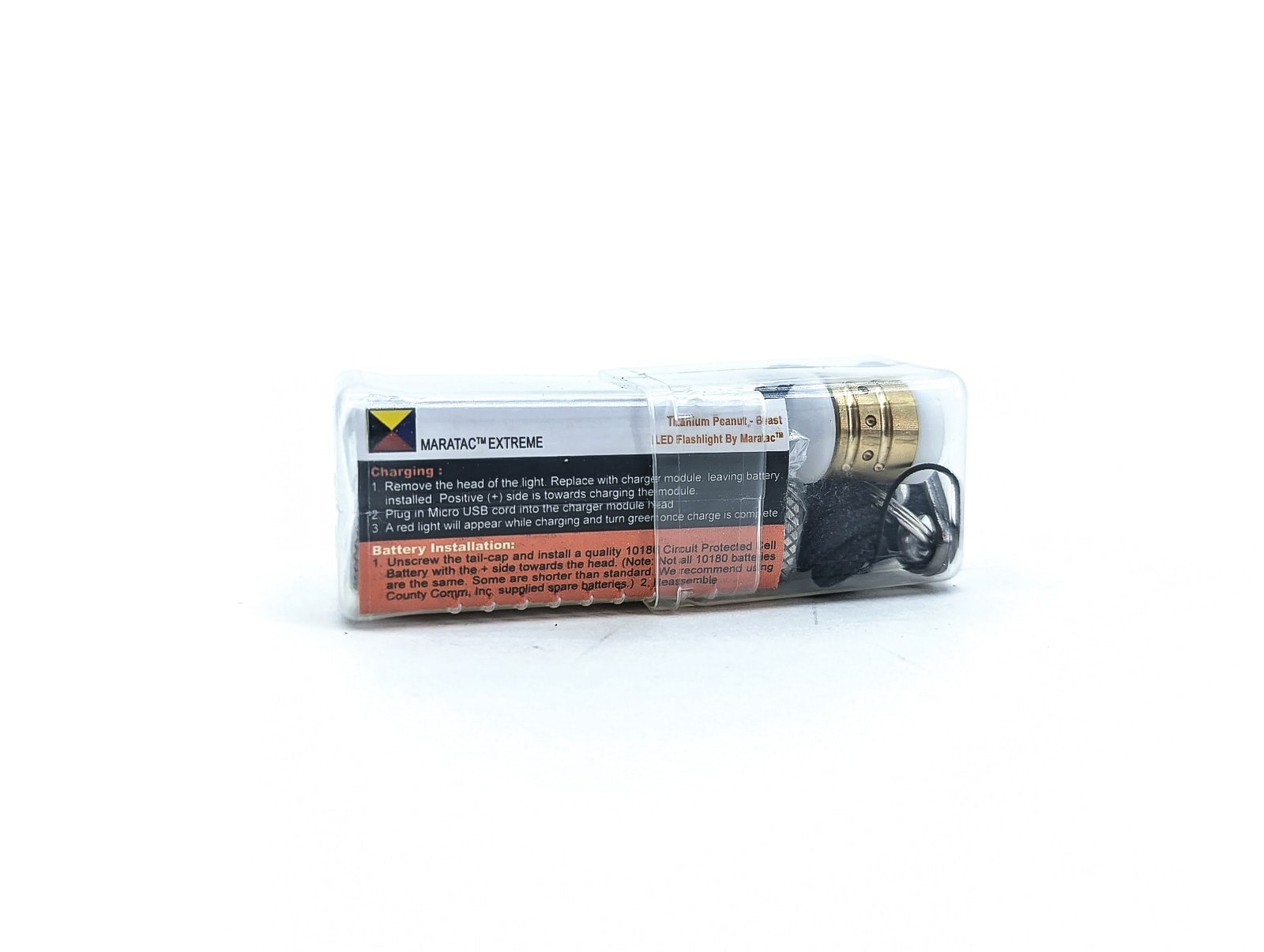
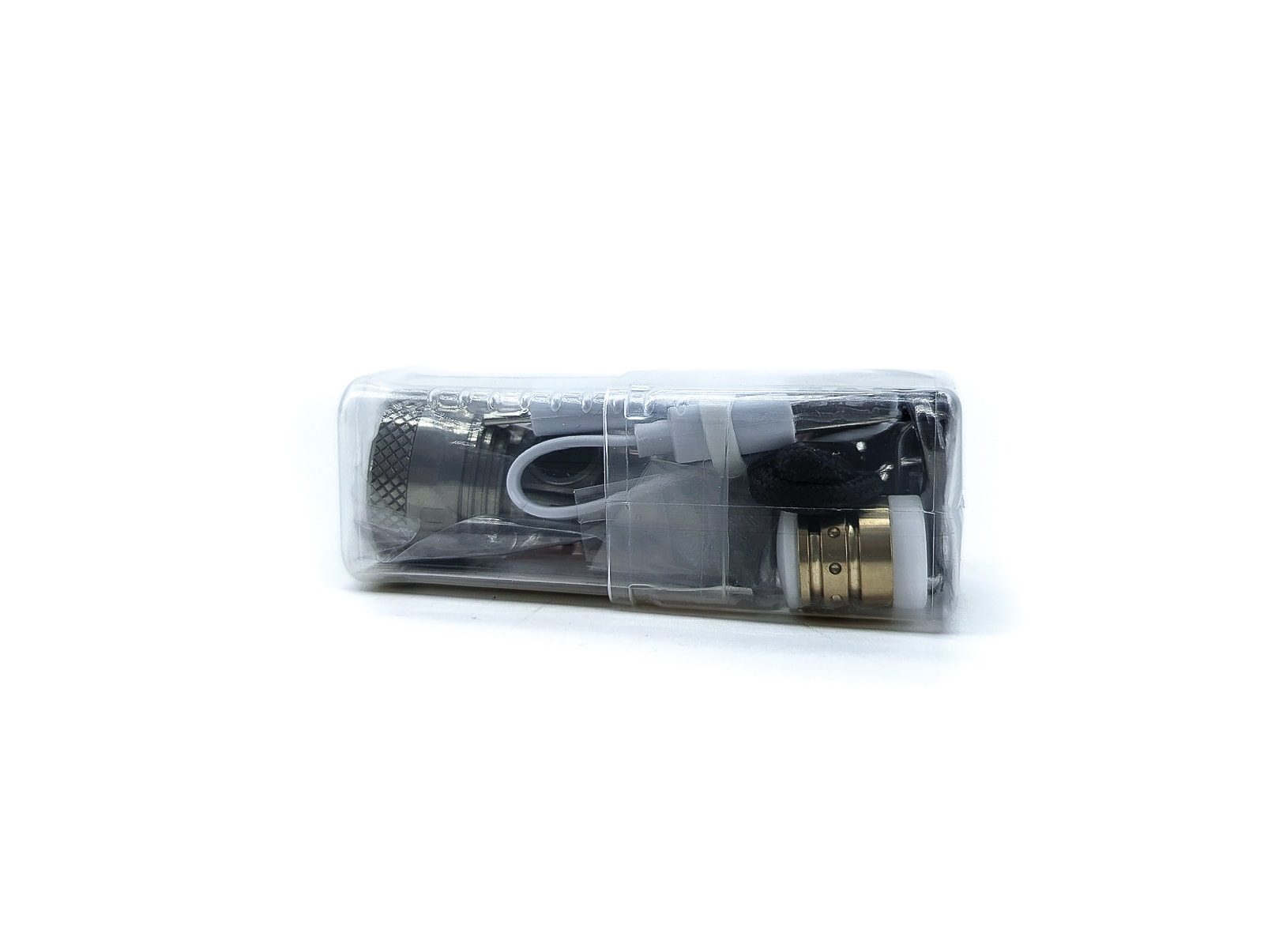
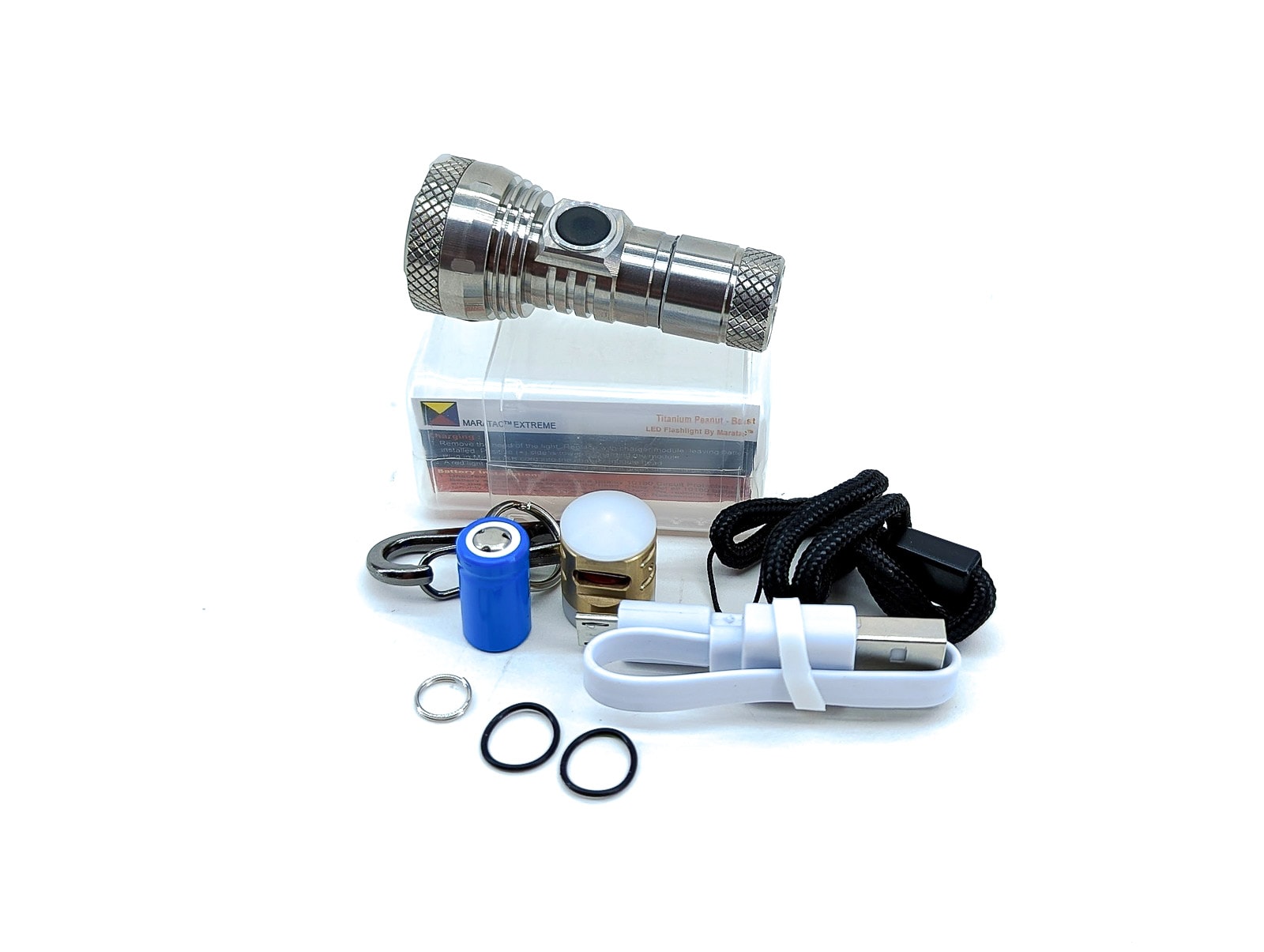
Flashlight in use
Normally when I think of keychain lights, I think of tiny little AAA-based tubes. They generally feature a twisty-head UI and a floody beam. So take all of that and throw it in the rubbish bin. This isn’t a tube; it’s not twisty, and it’s not at all floody. It has the shape of a traditional flashlight with an enlarged head featuring a sidewitch. Unlike strikingly-similar light that you might find elsewhere (the Lumintop GT Nano), this has nice knurling cut into the bezel and tail end that add a reasonable amount of grip. The lanyard and keychain clasp that are included are pretty standard stuff, but it’s nice that they’re in the package.
Since the Peanut-Beast has a throwy (comparatively) beam, it can be useful for things like quickly scanning the backyard, going for a short walk, or showing – especially with the eye-catching titanium build. Just know that this is not for extended use. The battery is less than half the size of a AAA, so runtimes are very short.

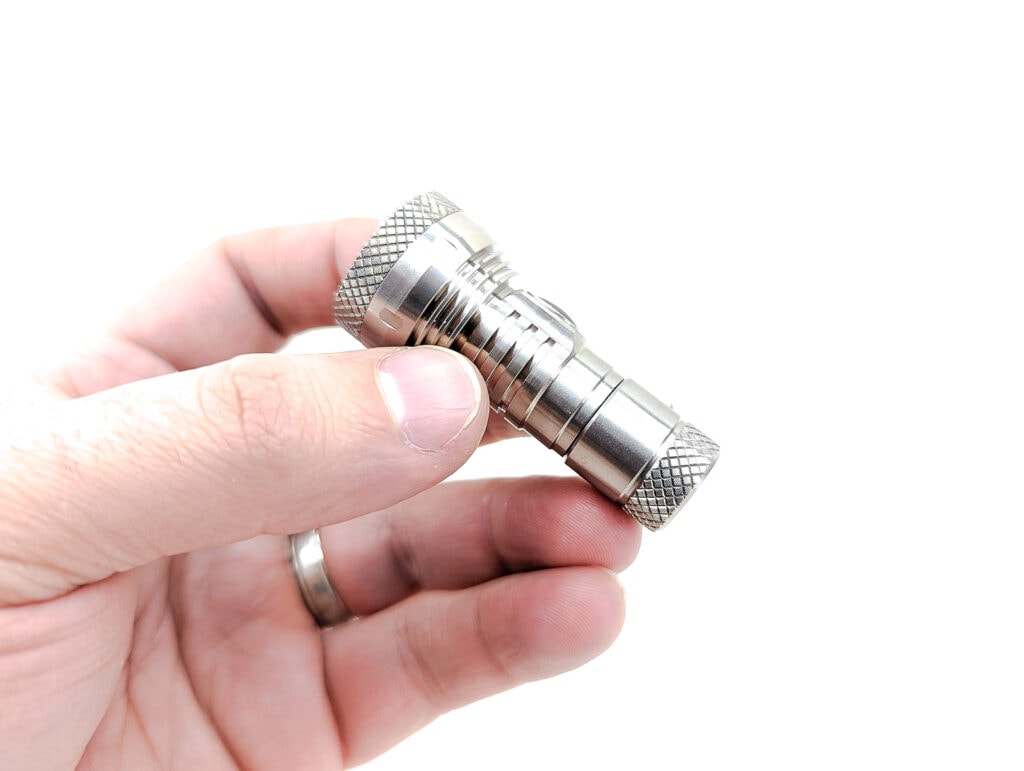
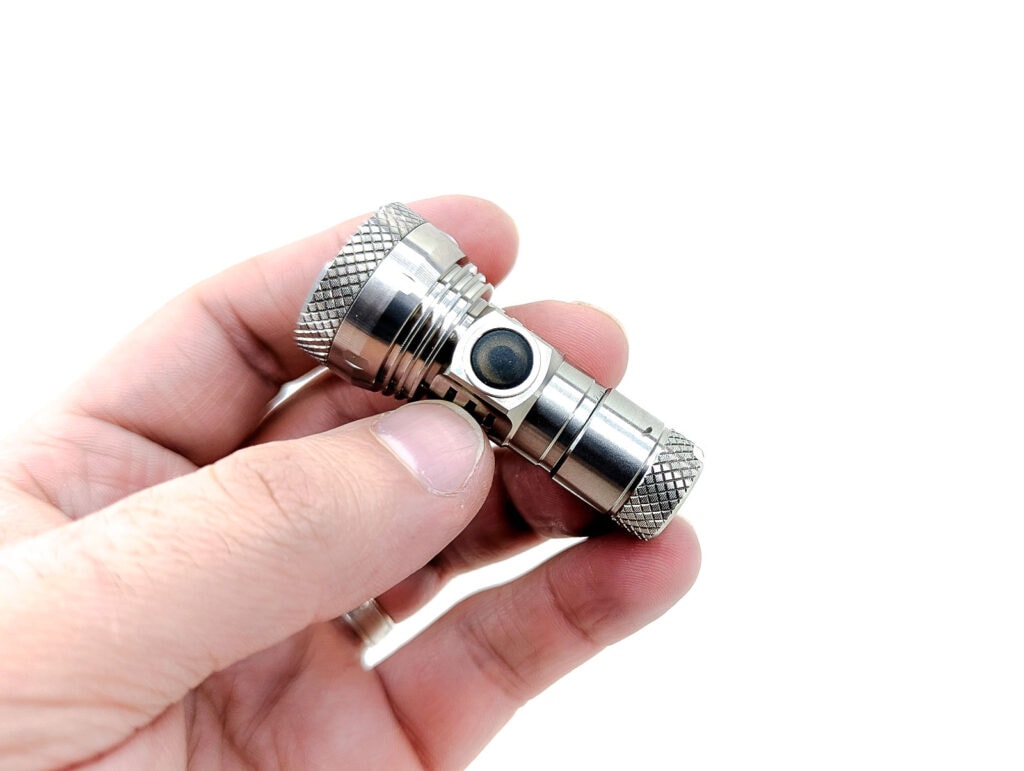
Build Quality and Warranty
The first thing you’ll notice, perhaps besides its diminutive size, is the gorgeous grade 6AL-4V titanium body. Titanium isn’t really all that practical for most flashlights. While it is extremely durable and reasonably light weight (compared to something like stainless steel or copper), it’s not as light as aluminum. And it’s pretty terrible as a heatsink. Those are actually ok here. The Peanut-Beast is so small that you might not notice the bump in weight. And runtimes are so short that heat buildup isn’t much of a concern.
As far as machining goes, everything looks really clean and smooth. There seems to be only one sharp area, and it’s a common one – the lanyard or split ring attachment point. That bump-out area could have used a chamfer.
Warranty:
The warranty seems simple and straight-forward, if maybe a little short. According to CountyComm: “Full 365 day warranty on all items we sell from defect or failure. We stand behind every product we sell 100% from watches to flashlights, we have you covered!”
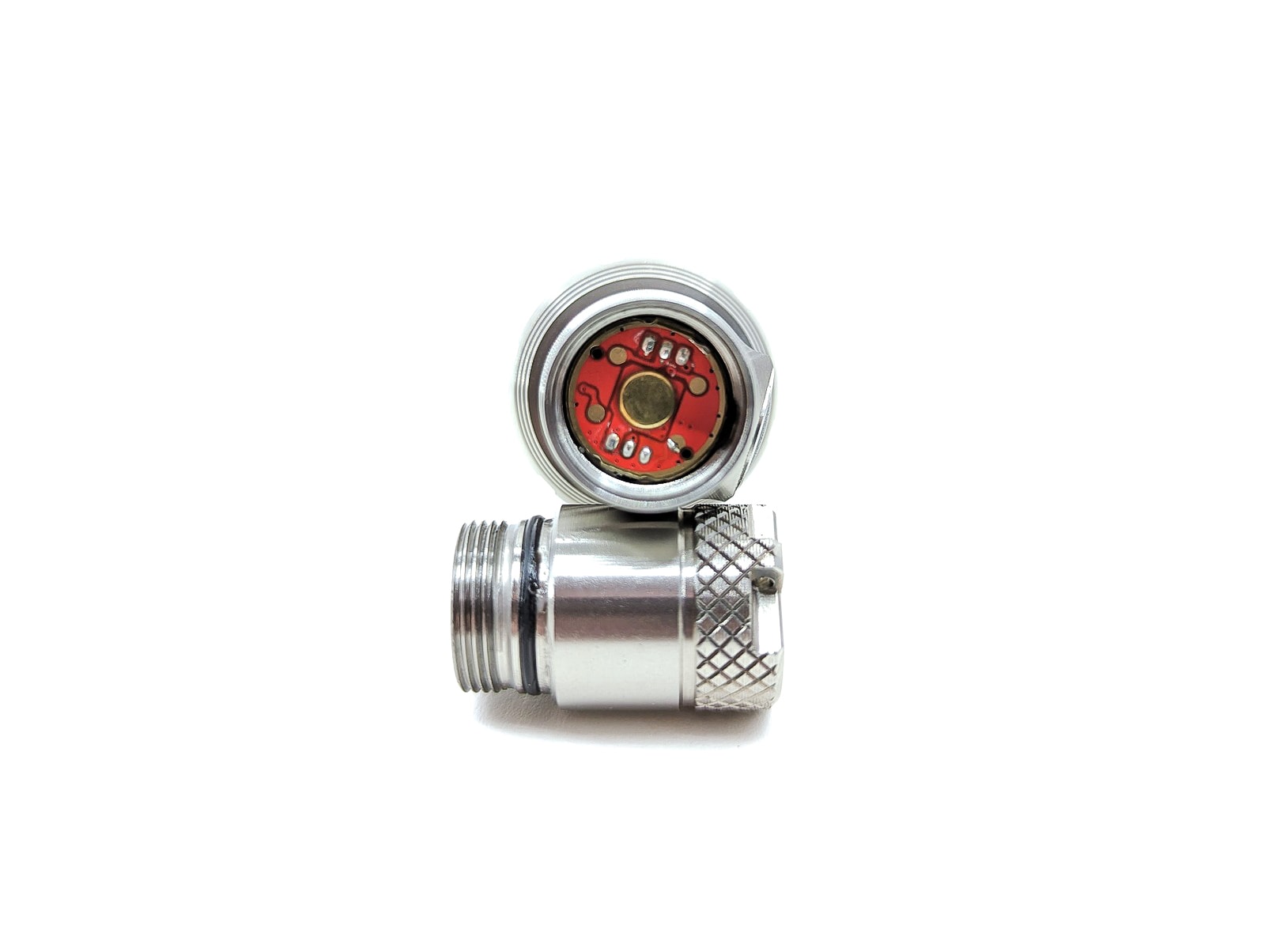
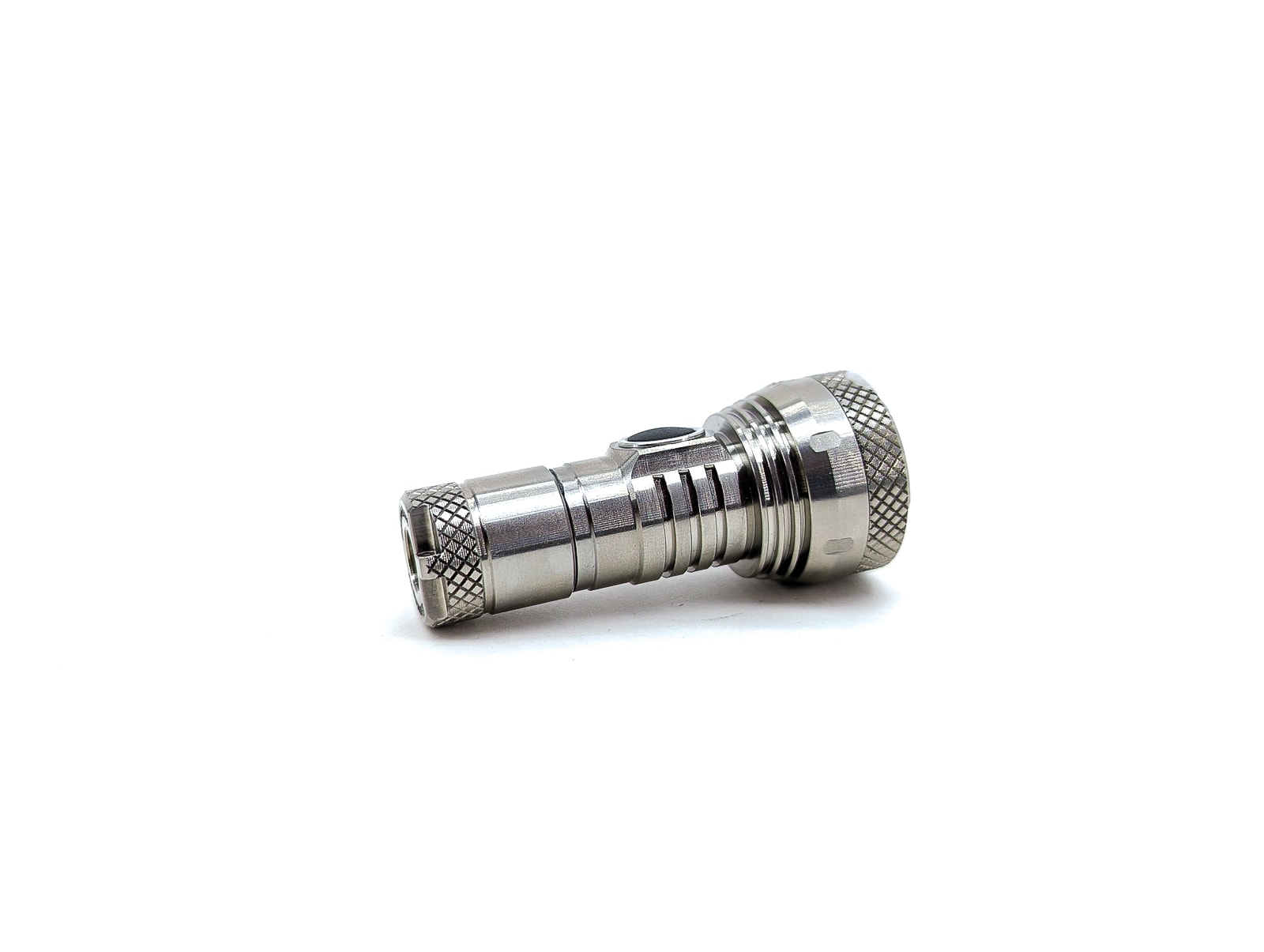
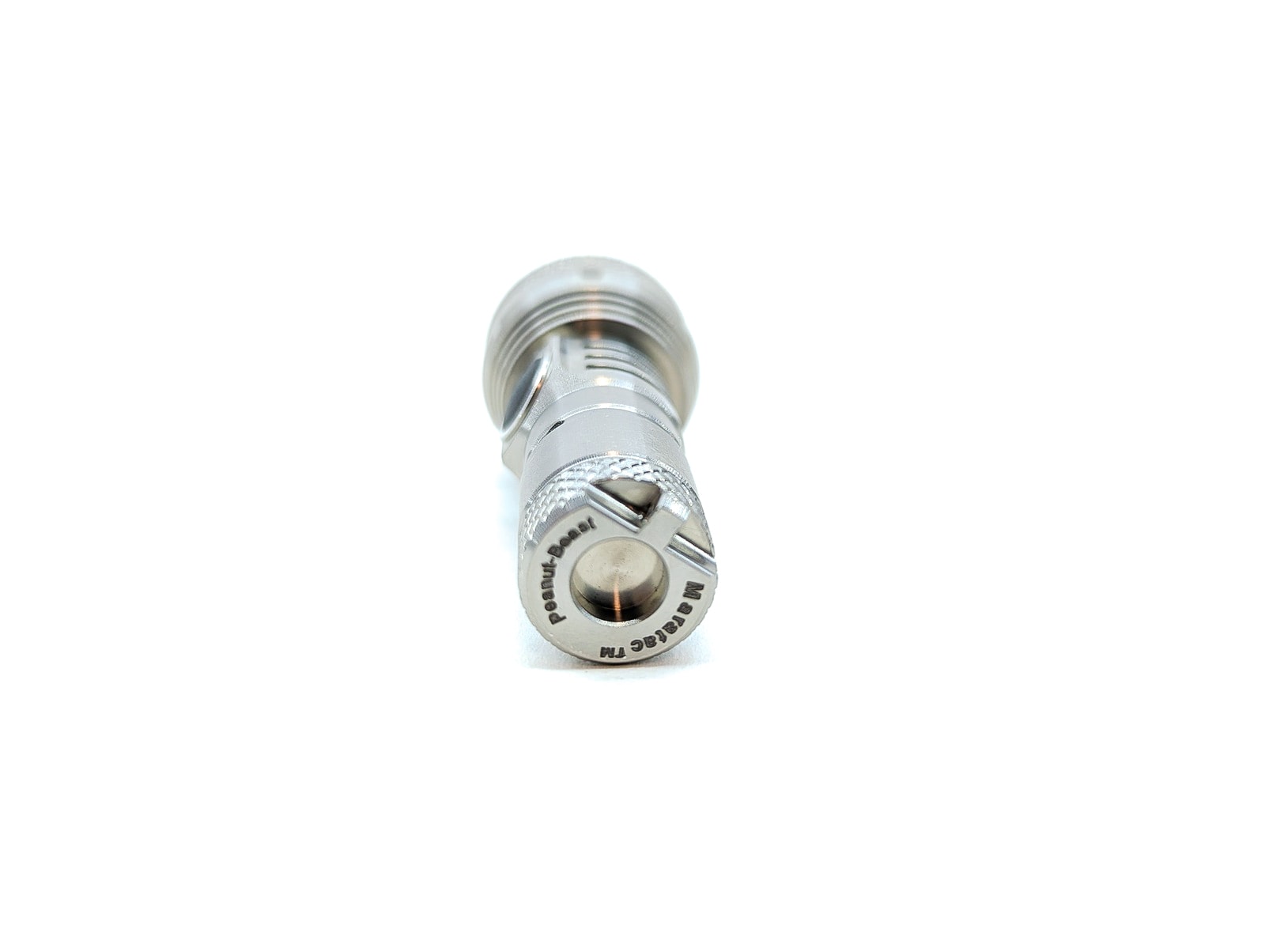
LED, Lens, Bezel, Beam, and Reflector
Aside from the titanium build, the other star of the show is the Osram KW CSLNM1 LED that they used in this Maratac light. That’s one of the most intense (candelas per lumen) LEDs in the flashlight space. Throw that LED in a smooth, large (for a keychain light) reflector and you’ve got a pretty tight beam. The Ti Peanut-Beast throws like no other keychain light I’ve seen.
The bezel of the Peanut-Beast has shallow crenulations. Within that bezel is a sheet of AR-coated glass, sitting atop the aluminum alloy reflector.
Opple Light Master reading from Turbo at 5 meters:
- CCT: 6591K
- CRI: 69.5 Ra
- DUV: +0.0003
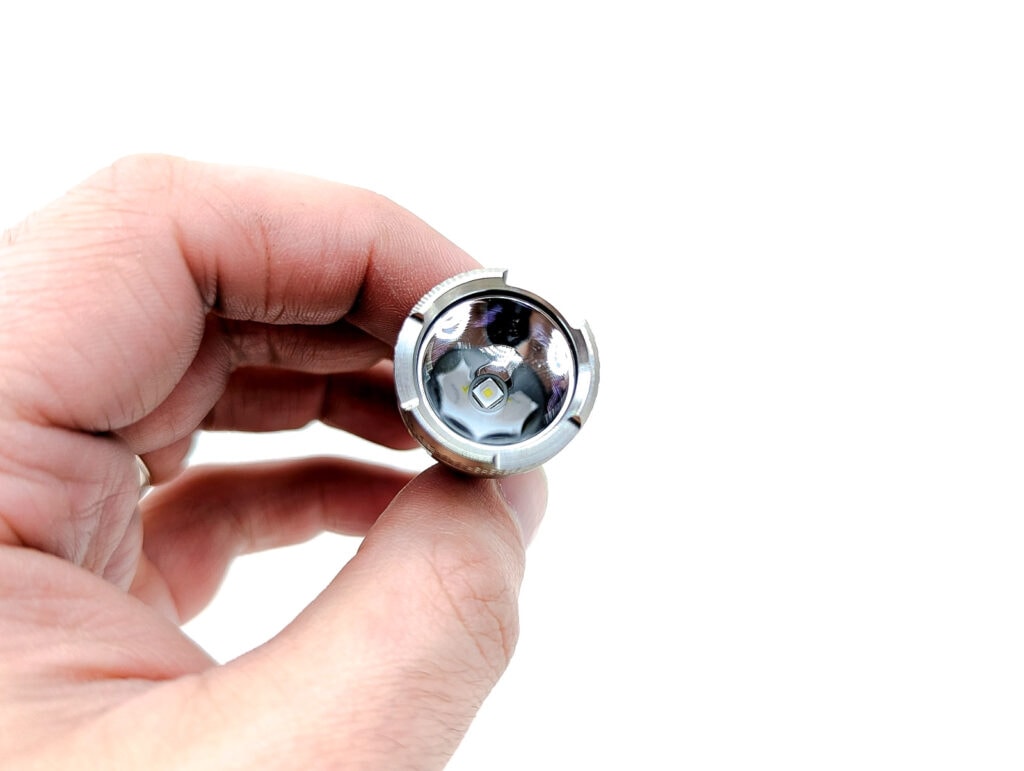
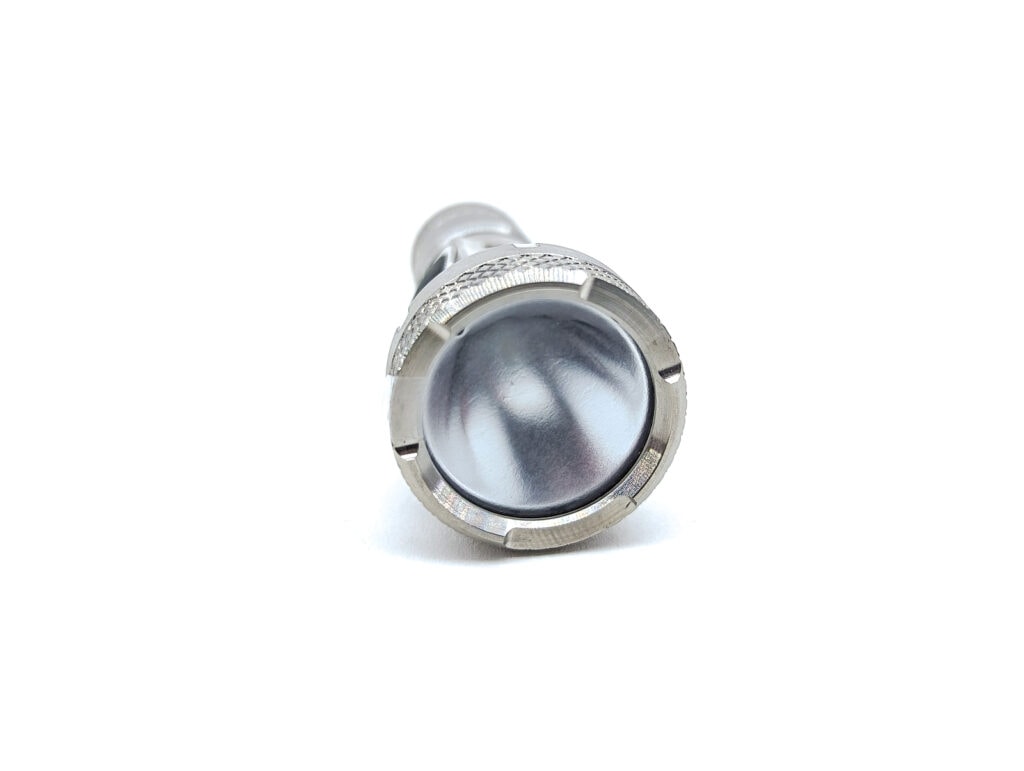
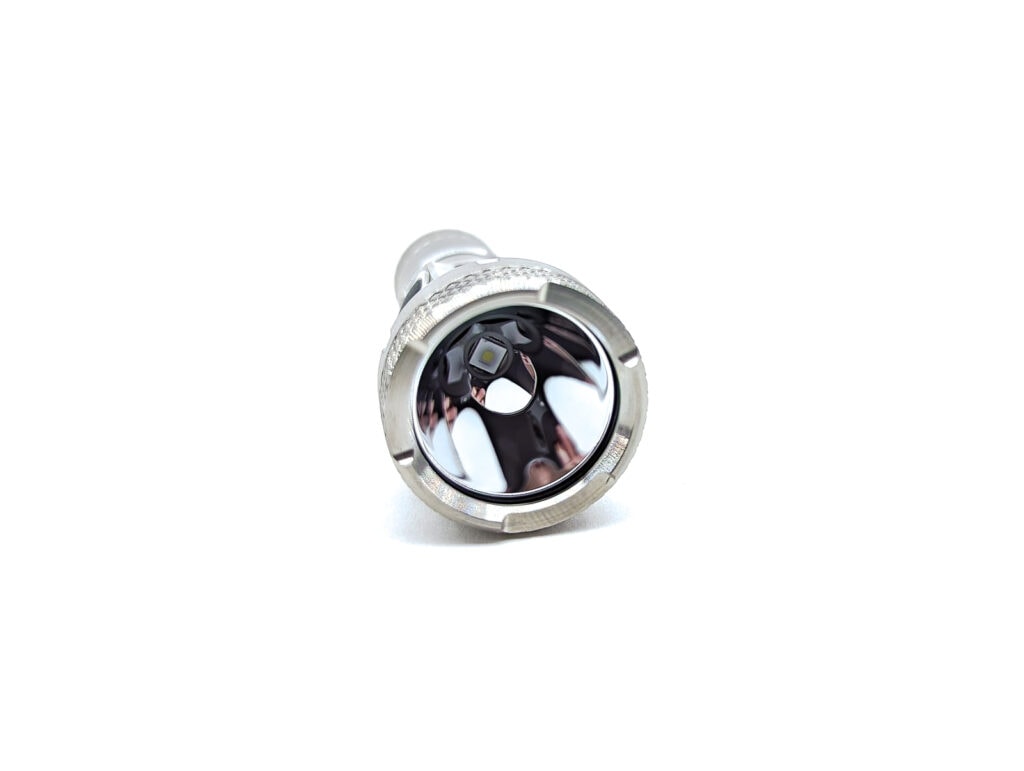

Dimensions and its competition
Dimensions:
| Millimeters | Inches | |
|---|---|---|
| Length | 54 mm | 2.1 in |
| Head diameter | 24 mm | 0.9 in |
| Body diameter | 14 mm | 0.6 in |
Dimensions are rounded to the nearest millimeter, and to the nearest tenth of an Inch.
Weight:
| Weight in grams | Weight in oz | |
|---|---|---|
| Without battery: | 28 g | 1.0 oz |
| With battery | 31 g | 1.1 oz |
Weight is rounded to the nearest gram, and to the nearest tenth of an Oz.
Flashlight size comparison with its competition:
Group 1: Astrolux LT1, Maratac Titanium Peanut-Beast, Lumintop Worm Damast, Reylight TI LAN
Group 2 keychain lights: Olight X9R Cell, Maratac Titanium Peanut-Beast, ThruNite Ti3 V2
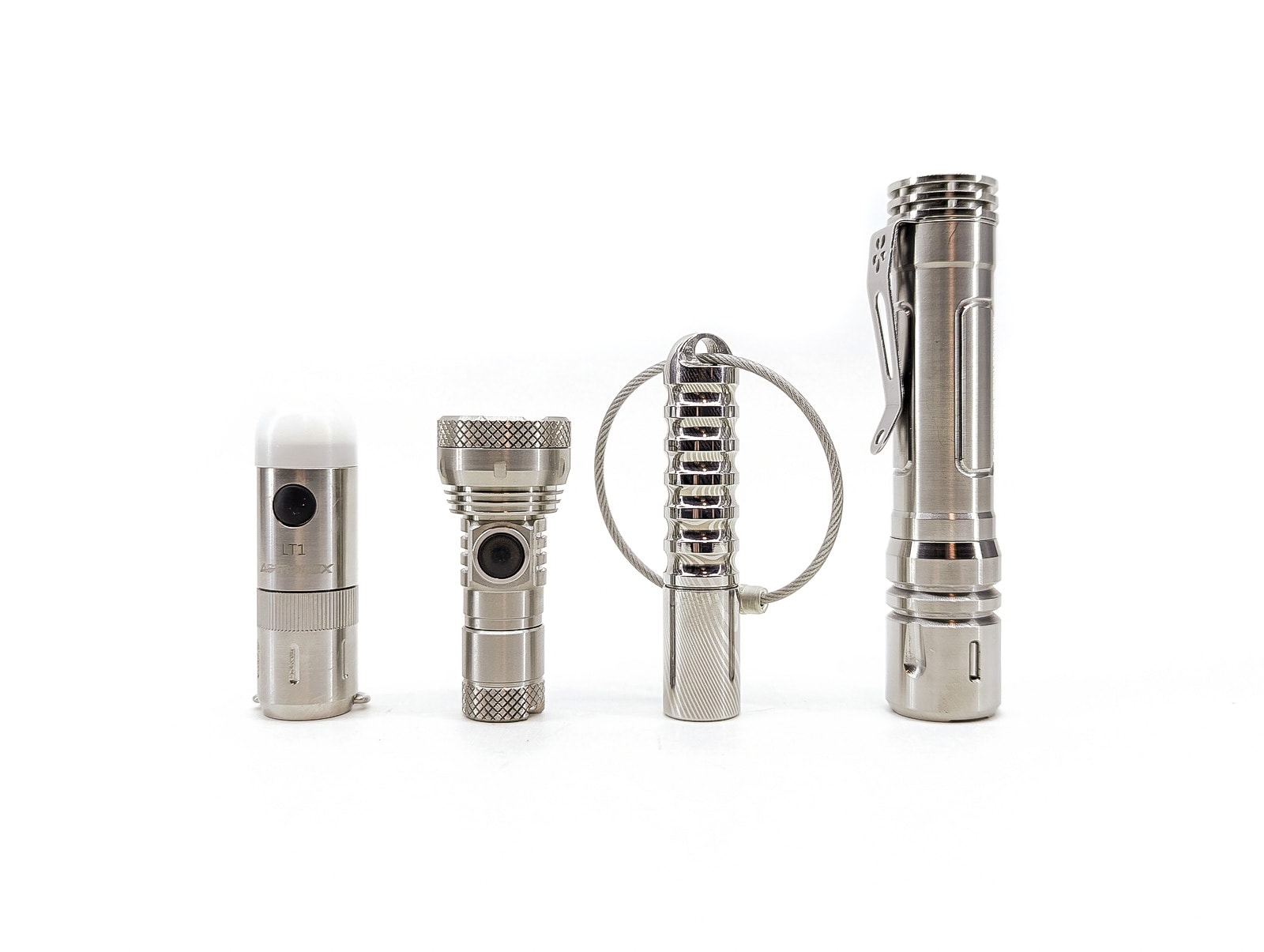
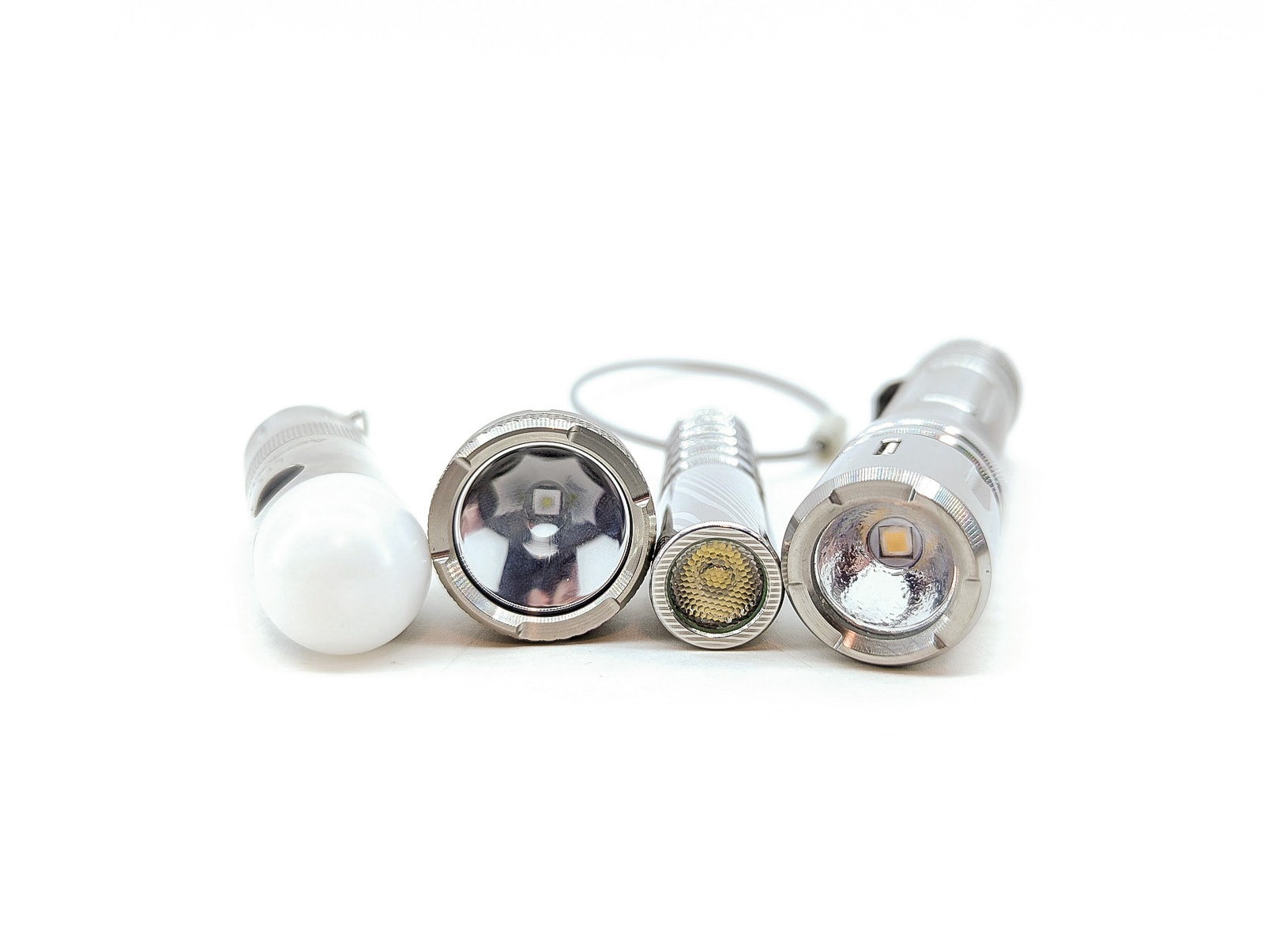
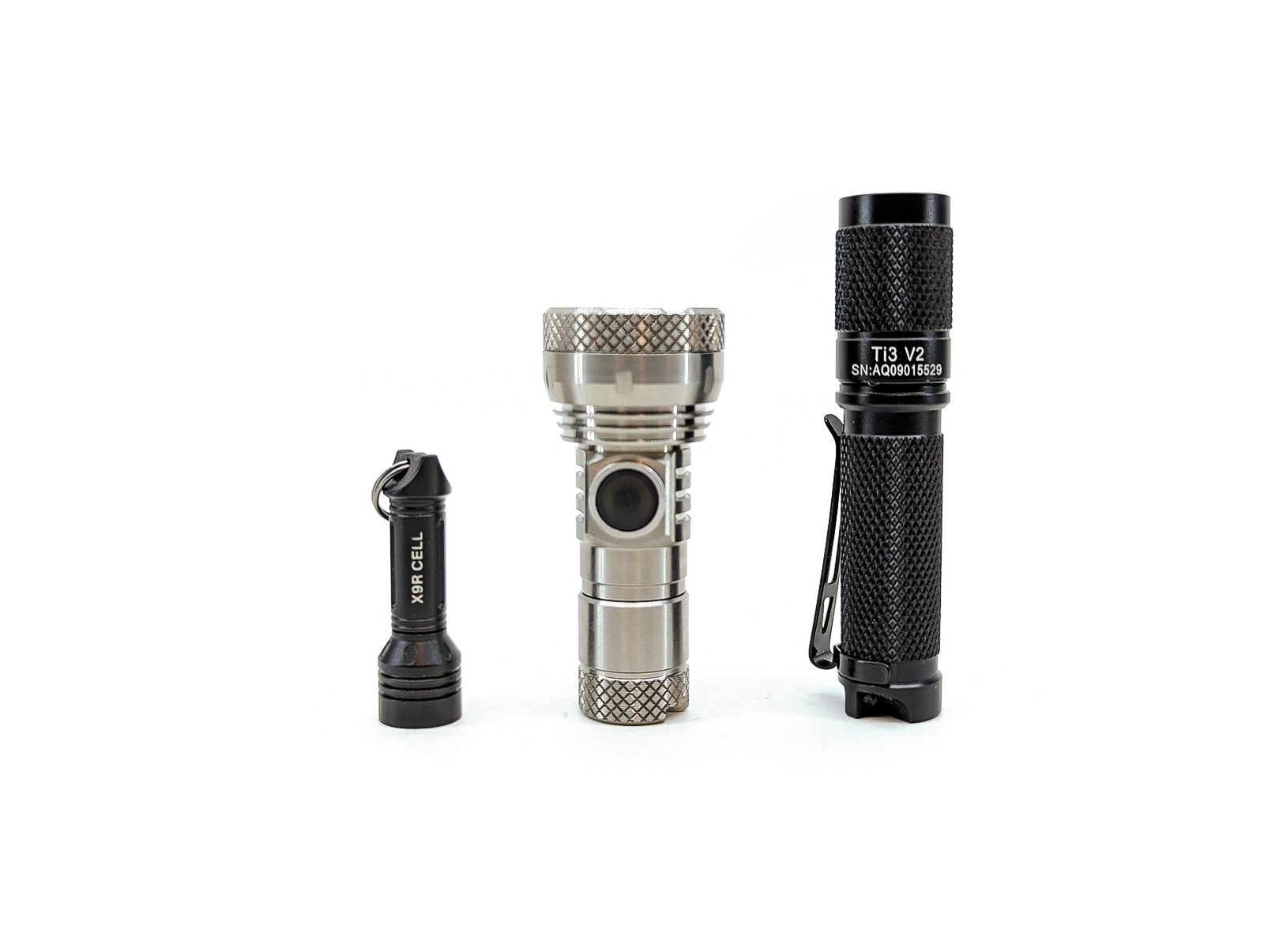
Maratac Titanium Peanut-Beast UI: User Interface and Driver
Available modes:
- Moon, Low, Medium, High, Turbo
Available blinky modes:
- N/A
From OFF:
- Press and hold: Moon
- Single click: turn on (last used mode)
- Double click: High (note: CountyComm says “double click any time to access Turbo”, but in my usage it seems to go to High on a double click from Off)
- 7 fast clicks: toggle switch backlight
From ON:
- Press and hold: turn Off
- 1 click: change modes (Low, Med, High)
- Double click: Turbo
Mode memory:
- Yes – Low, Medium, and High can be memorized
Shortcuts:
- To Moon: hold from Off
- To High: double click from Off
- To Turbo: double click from On
Low voltage warning:
- N/A
Strobe/blinkies
- N/A
Lock-out mode:
- N/A
PWM
- Moon mode does not have PWM
- Other modes (Low, Med, High) have 15.7 kHz PWM
Additional/summary info on the UI:
- The UI is about as simple as it gets. I’m not a huge fan of “hold for off”, but it works ok if you get used to it.
CountyComm’s instructions don’t mention the ability to turn the switch backlight on/off, but I noticed that on the Lumintop GT Nano’s instructions and decided to try it. It worked! Which is good, because the backlight drains the battery fast. From Off, quickly click the switch 7 times to toggle the backlight on/off.
Maratac Titanium Peanut-Beast Charging and batteries
The Maratac Titanium Peanut-Beast comes with a teeny-tiny 10180 lithium-ion battery. It’s pretty much the same diameter as a AAA battery, but only 40% as long. In order to charge the battery, you need to unscrew the head of the flashlight and remove it. Then screw the included charging head onto the light’s battery tube and you’re ready to plug it in. It’s Micro USB charging, which is a shame to see in 2023. It works, though, and Micro USB is unfortunately still common enough. When you plug it in, the end of the charger brightly glows red to indicate that it is charging. The light will switch to green when the charge cycle is complete. In my testing, I observed a 0.45 watt (0.09 amp at 5.28 volts) charge rate. The charge cycle was completed in 52 minutes.
It’s worth noting that CountyComm’s website points you to a listing for a 10440 adapter tube that gives you “400% more runtime.” Unfortunately, it takes you to a listing for black anodized aluminum tube. I don’t see where CountyComm offers a titanium version. Lumintop has produced some, though, so you may be able to find one floating around the internet.
CountyComm recommends for extended standby unscrewing the back end a ½ turn so that the button doesn’t use power. That’s nice and all for anodized lights, but that doesn’t work for this titanium model. They also recommend that you charge weekly or as needed. That’s kinda nuts. Do yourself a favor and turn off that indicator LED if you don’t need it.
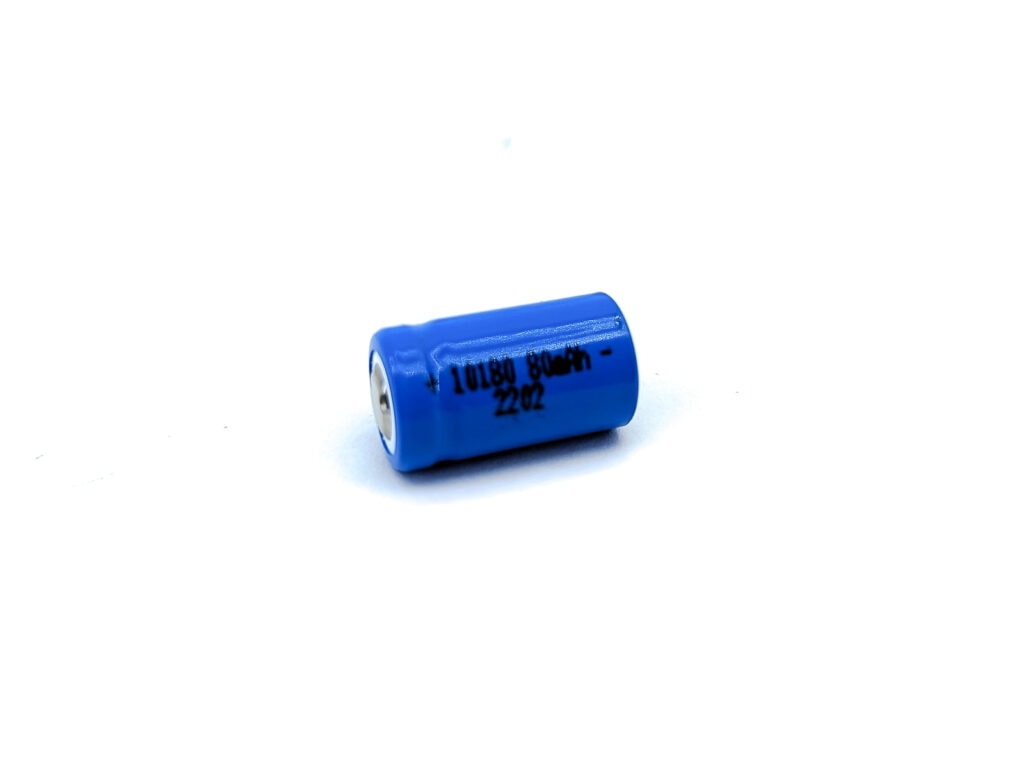
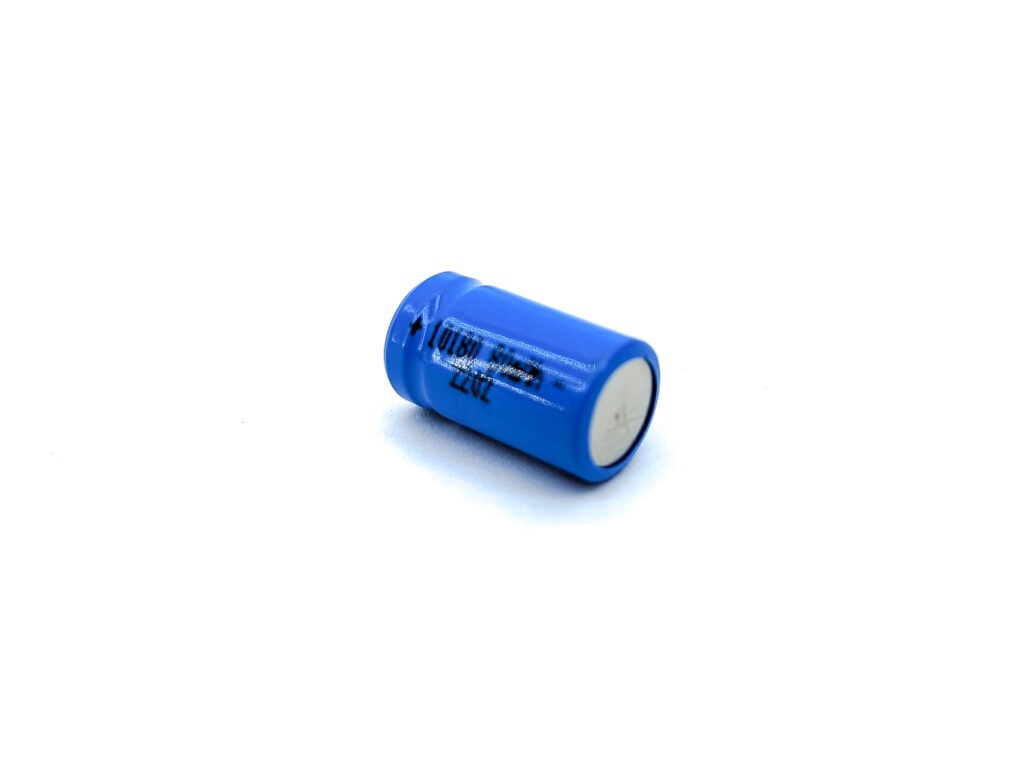
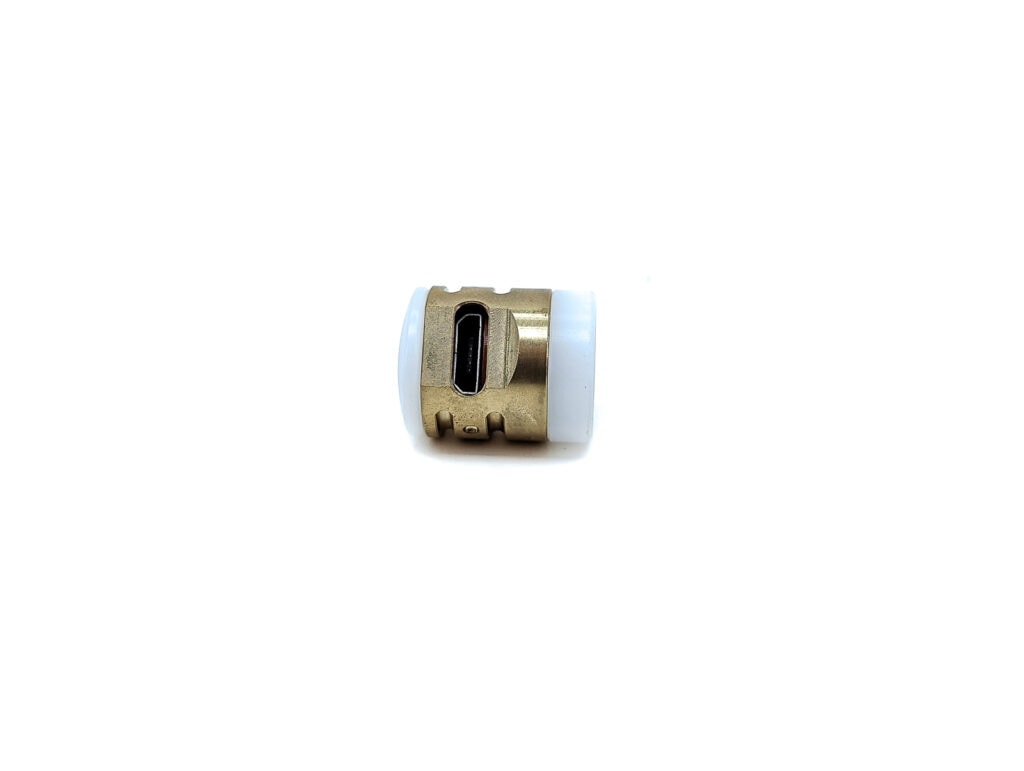
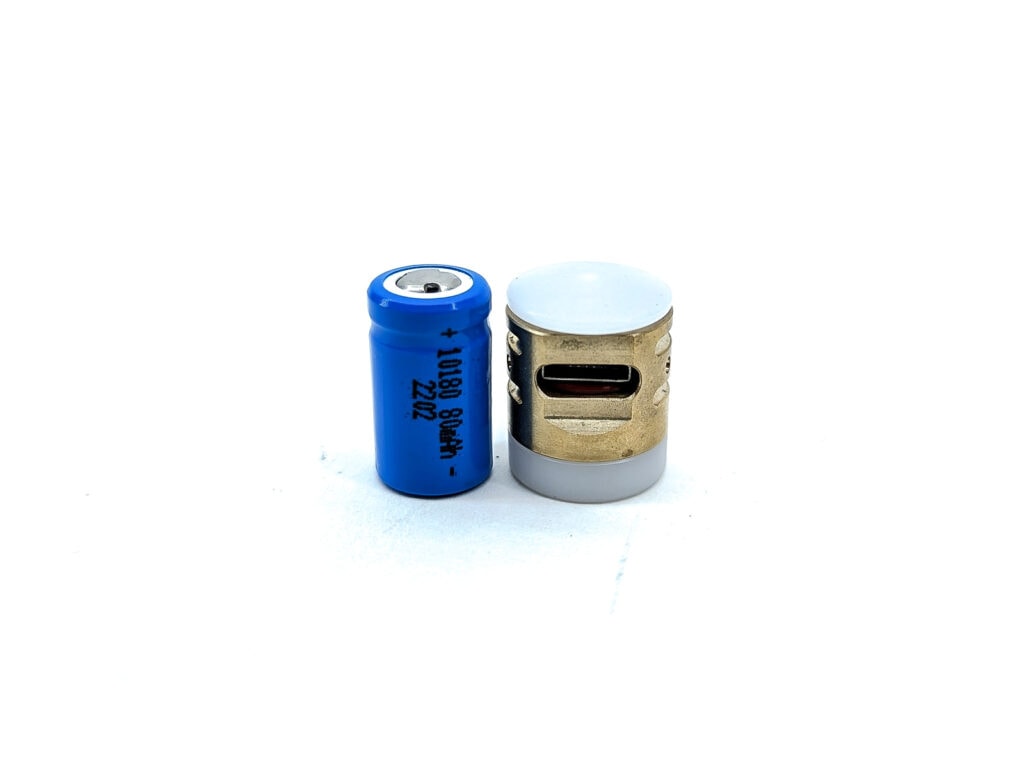
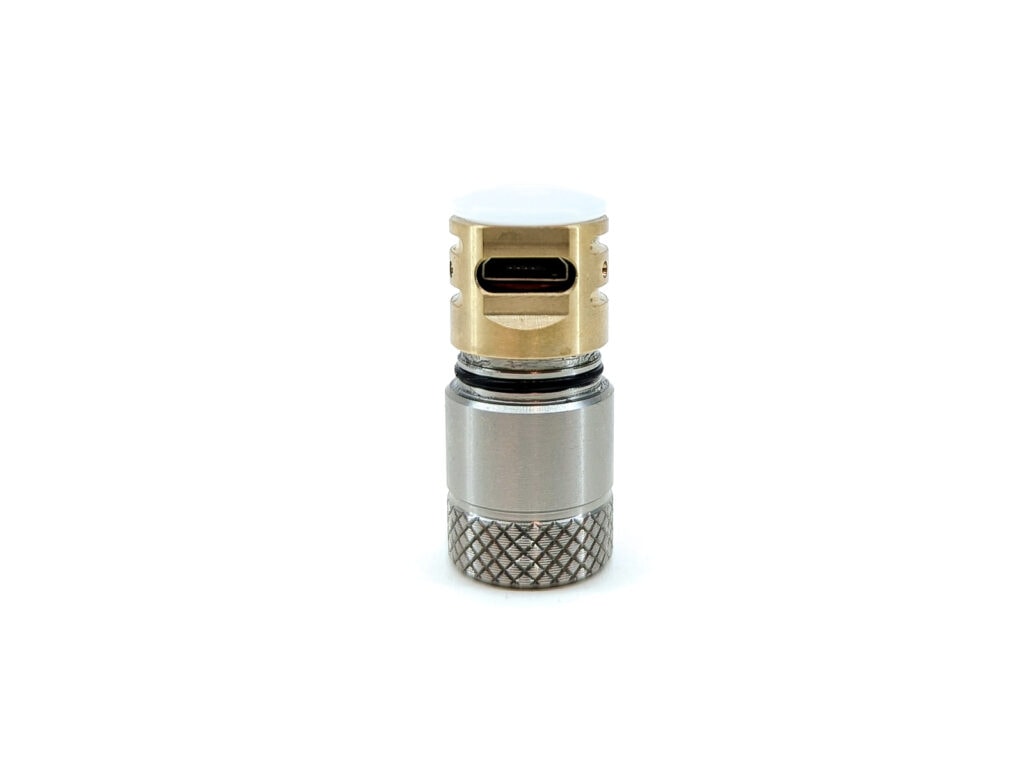
Performance test
Lux was measured by a UNI-T UT383 BT at 5 meters. Lumens were measured in a homemade lumen tube using a VEML7700 sensor, calibrated with a calibration light provided by 1Lumen. The included 10180 battery was used for testing.
Lumen measurements (for each mode)
| Mode | Amps at start | Specs | turn on | 30 sec | 10 minutes |
|---|---|---|---|---|---|
| Moon | 3.5 mA | 1 | 0.6 lm | 0.6 lm | – |
| Low | 85 mA | 70 | 24 lm | 24 lm | 16 lm |
| Med | 275 mA | 300 | 70 lm | 72 lm | 51 lm |
| High | 580 mA | 460 | 274 lm | 176 lm | 66 lm |
| Turbo | 1.3 A | 520 | 538 lm | 109 lm | 78 lm |
Parasitic drain:
- 246 µA with the indicator LED on (factory default) – note, this could completely drain the little battery in under 2 weeks!
- 49 µA with the indicator LED off – this increases the standby life to nearly 10 weeks. That’s still not a long time, but a lot better than with the indicator on.
If we’re talking about turn-on lumens, it’s good to see the Peanut-Beast attaining the factory spec for Turbo. That’s clearly not an ANSI FL1 number, though, as the 30-second reading is nowhere near the spec. The specs for the non-Turbo modes seem crazy. I have no idea where they got those numbers.
Battery Life: Runtime graphs
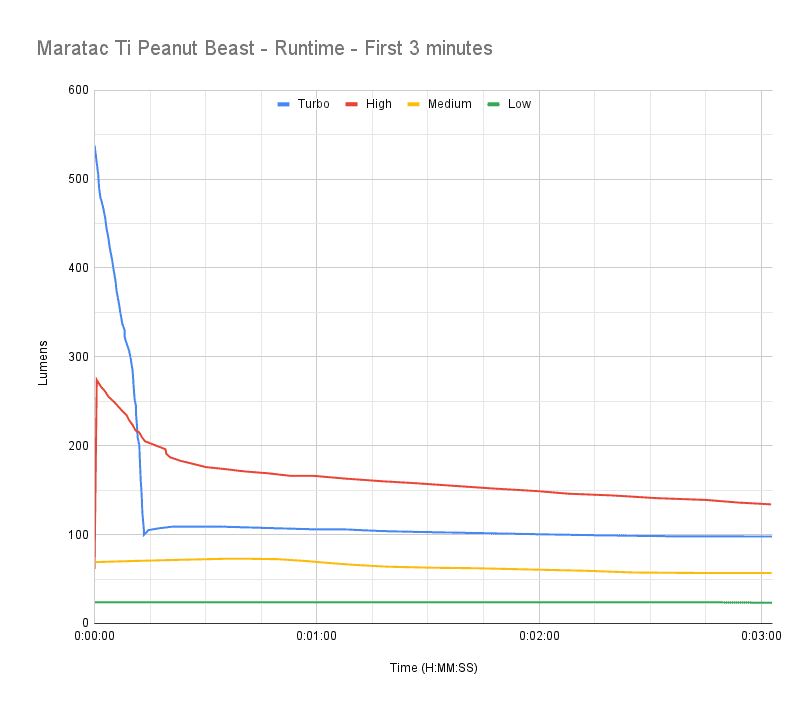
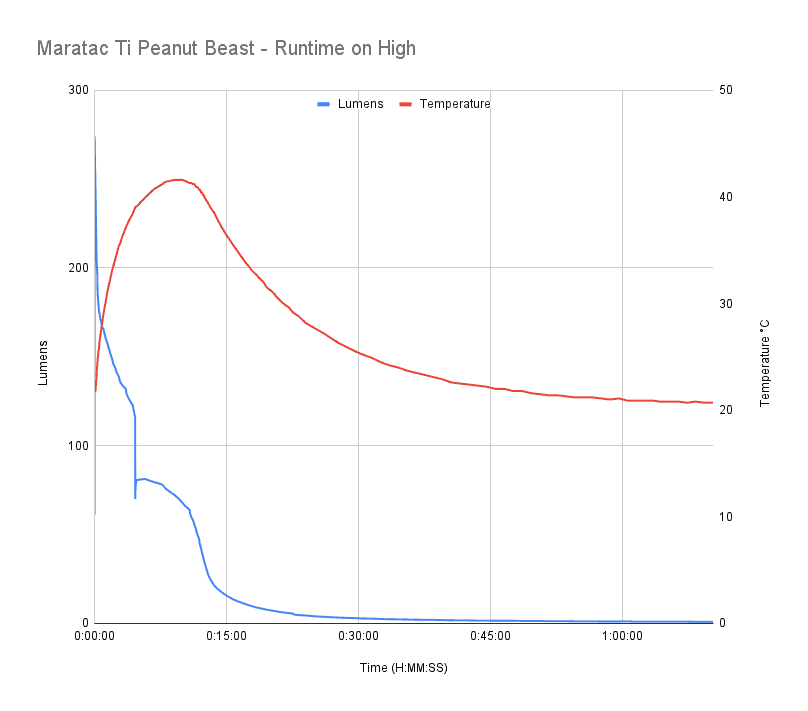
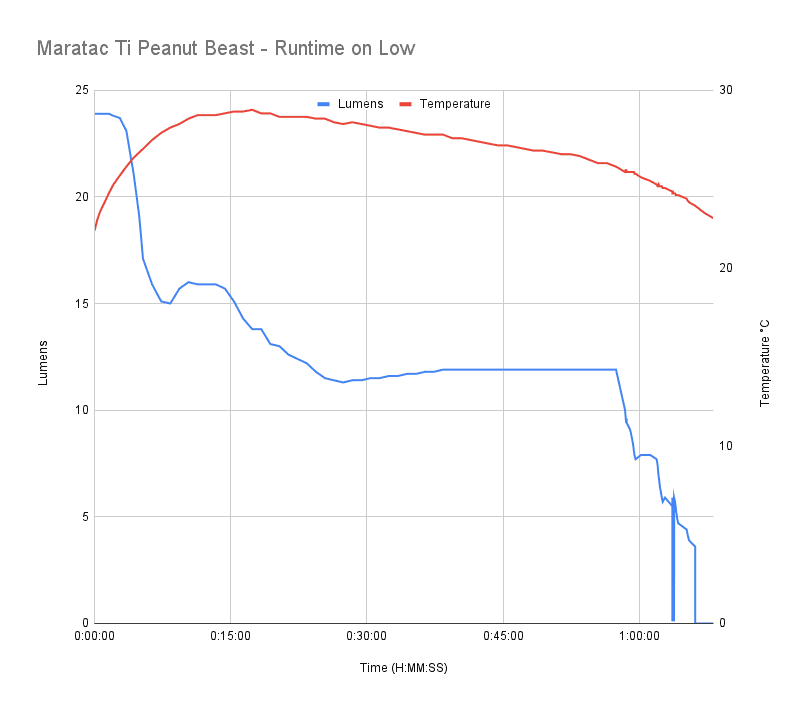
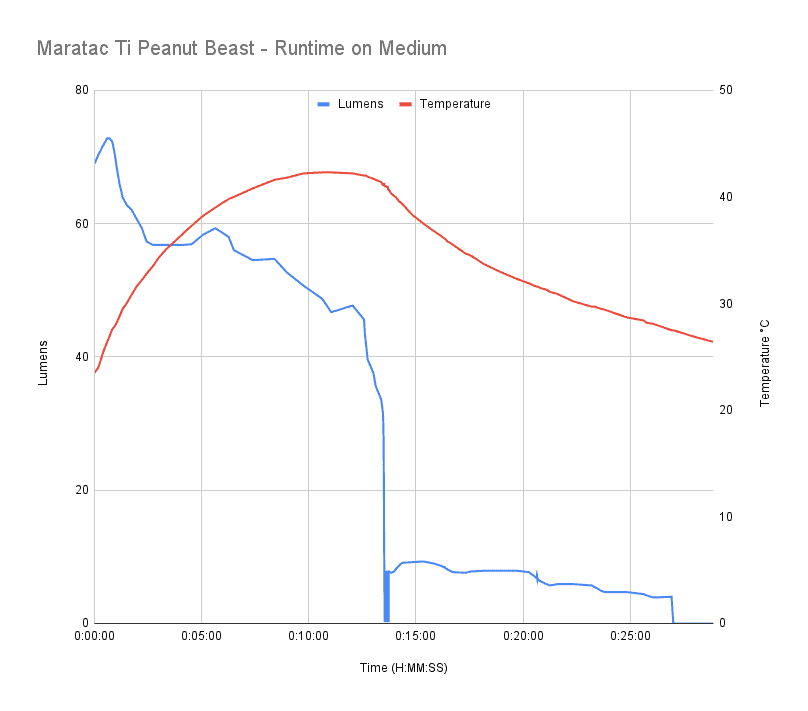
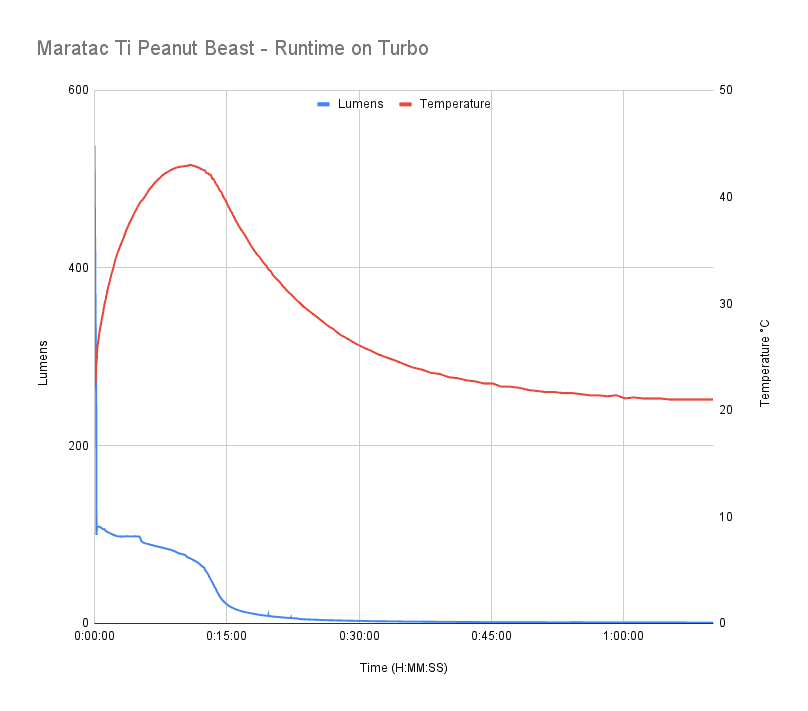
| Mode | Specified runtime | Measured runtime ANSI | Time till shut off |
|---|---|---|---|
| Moon | 12h | – | – |
| Low | 40min | 1h 6min | 1h 6mni |
| Med | 30min | 13min | 27min |
| High | 21min | 14min | 1h 10min+ |
| Turbo | 14min | 18min | 1h 10min+ |
The runtime lengths are more-or-less inline with the manufacturer claims. While Low and Medium had very distinct shut offs when they got low, High and Turbo just petered along for an extended time.
About ANSI FL1 standards: The runtime is measured until the light drops to 10% of its initial output (30 seconds after turning on). This does not mean that the flashlight is not usable anymore. The last column shows how long the light actually works till it shuts off. If there is a + symbol, it means that the test was stopped at that particular point, but the light was actually still running. This happens on certain occasions, with certain drivers, firmware, or batteries.
Peak beam intensity and beam distance measurements
Intensity was measured at 5 meters after being turned on for 30 seconds (unless otherwise noted). A UNI-T UT383 BT lux meter was used.
| Mode | Specs | Candela measured | Meters | Yards |
|---|---|---|---|---|
| Low | – | 750 cd | 55 m | 60 yd |
| Medium | – | 5,125 cd | 143 m | 156 yd |
| High | – | 10,125 cd | 201 m | 220 yd |
| Turbo @ 0sec | 24,180 cd* | 28,250 cd | 336 m | 367 yd |
| Turbo @ 30sec | – | 7,250 cd | 170 m | 186 yd |
* Note that CountyComm does not provide a candela measurement. Rather, they list it as “max beam throw 1020 feet” and I worked the math backwards.
Much like the lumen test, I actually measured a bit higher than spec… at turn-on time. Definitely not at 30 seconds. So we’re looking at max values on the manufacturer ratings, not ANSI FL1 specs.
About peak beam intensity: Peak beam distance according to ANSI FL1 standards: The calculated value of distance in meters at which the flashlight produces a light intensity of 0.25 lux. (0.25 lux is about the brightness of a full moon shining on an object). The columns ‘Meters’ and ‘Yards’ use rounded numbers
Beamshots
Camera settings and distance:
Beam shots of the building are taken at 30 m (33 yd) using a Pixel 7 set to ISO 800 with 1/10 second exposure time
Beamshots of the following flashlights compared:
- Maratac Titanium Peanut-Beast
- Olight Arkfeld UV
- Olight Baton 3 Pro Max



Disclaimer: This flashlight was sent to me for review at no cost by County Comm. I have not been paid to review, nor have I been holding back on problems or defects.
Final Verdict
Pros
- Beautiful & durable titanium build
- Very throwy for a keychain light
- Full kit – includes battery and charger
- Simple UI
Cons
- Very short runtimes
- Not reaching claimed outputs
- Short standby time
- Charging is Micro-USB
Explanation on star ratings:
1: Avoid: a match would be a better choice – 2: Poor: significant defect or issues; almost unusable – 3: Average: some defects or issues; but still usable 4: Good: recommended (minor issues) – 5: Great: highly recommended

3.5 stars: ★★★⋆
Some flashlights are very practical. And shouldn’t they be? At their heart, they are a tool. But some lights are more centered around enthusiasts. With how the Maratac Titanium Peanut-Beast ships from CountyComm, I feel like it’s definitely in the enthusiast realm. It has a beautiful titanium build. With its ~2 week standby time, it is not practical at all. Who is going to remember to recharge a keychain light every single week, as is the recommendation? Certainly not your average Joe.
While I don’t see that CountyComm says anywhere about being able to disable the indicator LED, I absolutely recommend doing so, which extends the standby life to around 10 weeks. That’s not great, but it’s a lot better than letting your light go unused for 2 weeks and then realizing that it’s dead as a doornail. A 10 week standby time is a lot easier to recommend in a usable keychain light. I really hope they can either disable the indicator from the factory or at least include the instructions on how to do so.
All of that battery life craziness aside, I really do like the Titanium Peanut-Beast. The titanium body should be really durable and look great for a long time, and it has a very usable throwy beam that truly is a beast for its relative size.
Buy your Maratac Ti Peanut Beast
1lumen selects and reviews products personally. We may earn affiliate commissions through our links, which help support our testing.